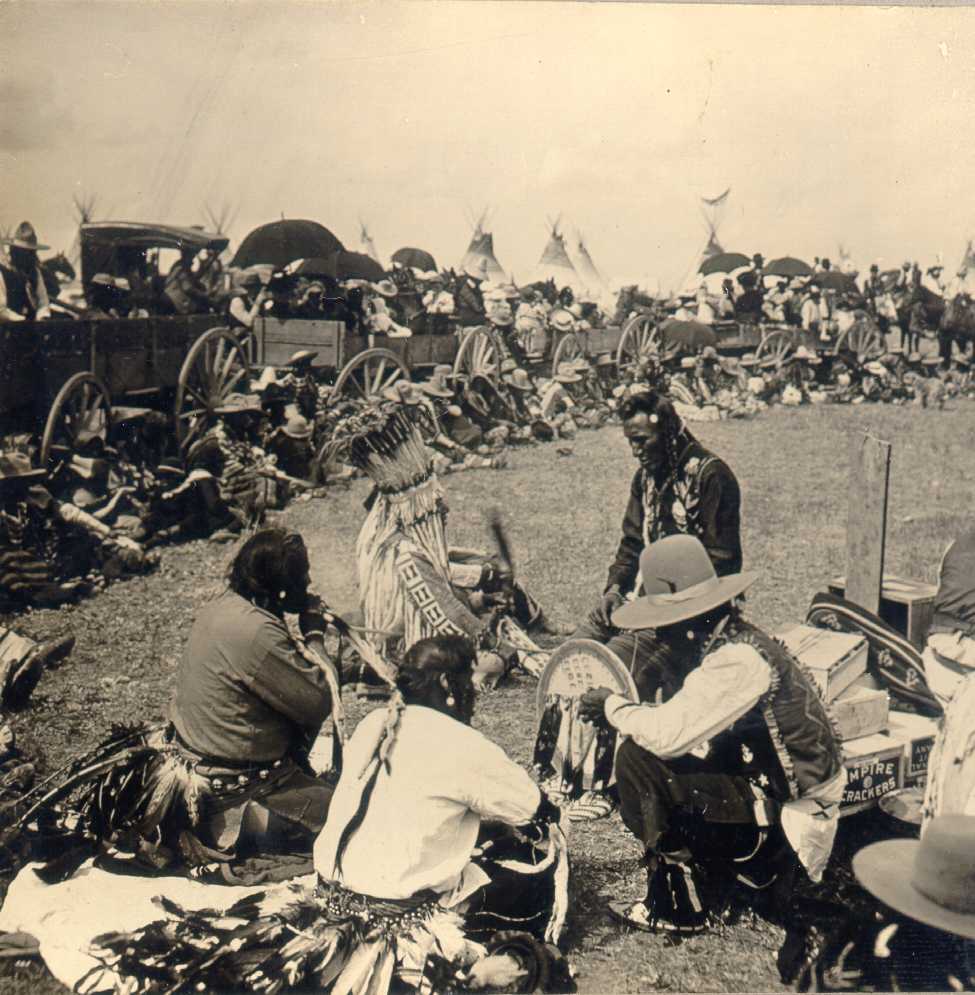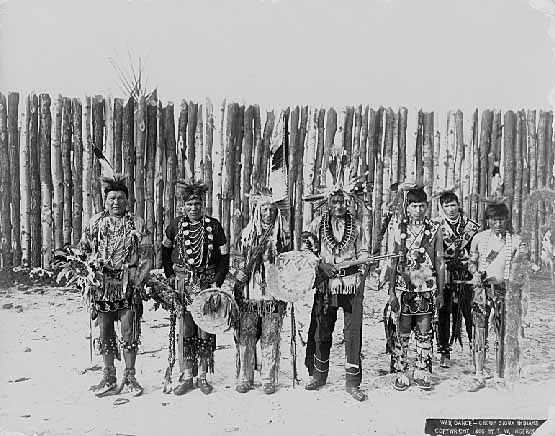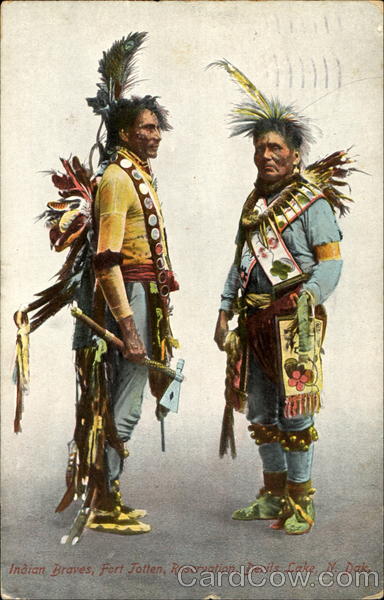Post by HinTamaheca on Jul 26, 2009 14:14:35 GMT -6
In the earliest versions of the Hethuska dance ceremony, some dancers among the Omaha/Ponca were entitled to wear a feathered bustle called the Kaxe’ or “Crow.”
A description of the early form of this feather bustle can be seen in the work titled Hae-thu-ska Society of the Omaha Tribe, which appeared in the Journal of American Folk-lore published in 1892, and it states,
"The Leader and other men distinguished for their skill and success in war, wore an ornament called Ka-hae, or ‘Crow’. This was made of two sticks like arrow shafts, painted green, and feathered like the stems of the fellowship pipes, with feathers of the buzzard; tufts of crow plumage and long pendants reaching nearly to the ground, made of crow’s feathers completed this ornament, which was worn at the back fastened to the belt, the two shafts rising to the man’s shoulder blades. The men wearing the Ka-hae; painted the front of their bodies and their arms and legs with daubs of black; their faces and backs were completely covered with black paint, but on their backs, white spots were put on the black color.
Comparatively few men attained sufficient eminence as warriors to wear the Ka-hae and paint themselves in this manner. The blackened face and dappled limbs and front were emblematic of the thunder clouds and their destructive power as they advance over the heavens, even as the warrior approaches his victim dealing his death-darts. The blackened back with it’s white spots indicated the dead body of the enemy, which the birds were busy pecking, leaving their droppings as they tore away the fast-decaying flesh. The crow was worn, as it was said to be the first to find a corpse, and later was joined by other birds of prey. The tuft of grass worn by all the members of the Hae-thu-ska bore a twofold signification: it represented the tail of the Me-ka-thu, or wolf, the animal closely allied to the warrior, and it also symbolized the scalp of the vanquished enemy.
There are two classes of warlike deeds, which are distinguished in according honors:
1st. Nu ah-tah’-the-sha. Literally the words mean, in the direction of men, signifying that the warrior has gone forth seeking men to fight; one whose warfare has been aggressive, and away from home.
2nd. Wa-oo ah-tah’-the-sha, or Tee ah-tah’-the-sha. Literally the words mean, in the direction of woman, or in the direction of the tent or home; defensive warfare, as when the camp or village has been attacked and valorously defended. Only men of the first class, those whose aggressive warfare has become noted, and confirmed through the ceremonies of the Tent of War, are eligible to the office of Leader, or permitted to wear the Ka-hae and paint in black as already described."
(Fletcher, 1892, pp. 138-139)
By 1911, Alice Fletcher and Francis LaFlesche described the feather bustle or “the Crow,” in a work titled The Omaha Tribe, in the following way,
“A man who had attained more than once to honors of the first three grades became entitled to wear a peculiar and elaborate ornament called ‘the Crow.’ This was worn at the back, fastened by a belt around the waist; it was made with two long pendants of dressed skin painted red or green, which fell over the legs to the heels. On the skin were fastened rows of eagle feathers arranged to hang freely so as to flutter with the movements of the wearer. An entire eagle skin, with head, beak and tail formed the middle ornament; from this rose two arrow shafts tipped with hair dyed red. On the right hip was the tail of a wolf; on the left the entire skin of a crow.”...
...“The ‘Crow’ decoration is said to symbolize a battlefield after the conflict is over. The fluttering feathers on the pendants represented the dropping of feathers from the birds fighting over the dead bodies. Sometimes the wearer of ‘the Crow’ added to the realism by painting white spots on his back to represent the droppings of the birds as they hovered over the bodies of the slain. The two arrow shafts had a double significance; they represented the stark bodies and also the fatal arrows standing in a lifeless enemy. The eagle was associated with war and with the destructive powers of the Thunder and attendant storms. The wolf and the crow were not only connected with carnage but they had a mythical relation to the office of ‘soldiers,’ (wa-noN’-she) the designation given to certain men on the annual tribal hunt, who acted as marshals and kept the people and the hunters in order during the surround of the herd. These men were chosen from those who had the right to wear ‘the Crow’ and this regalia was generally worn at that time. It was worn also at certain ceremonial dances.”
(Fletcher & LaFlesche, 1911, pp. 441-442)
Fletcher, Alice C.
1892. Hae-thu-ska Society of the Omaha Tribe. Journal of American Folk-lore, Vol. 5, No. 17, American Folk-Lore Society, Boston, MA.
Fletcher, Alice C. and Francis LaFlesche.
1911. The Omaha Tribe. Bureau of American Ethnology, 27th Annual Report 1905-06, Smithsonian Institution, U.S. Government Printing Office, Washington, D.C.
It should be noted that while these descriptions are the result of talking with many Omaha people in the late 1800s and early 1900s, the descriptions portray a limited viewpoint.
It should also be noted that Francis LaFlesche, (French/Ponca/Iowa/Omaha, b. 1857 - d. 1932) was the son of an Omaha Chief named Iron Eye (aka Joseph LaFlesche). Iron Eye had become the adopted son of Chief Big Elk of the Omaha, and Big Elk personally selected Iron Eye as his successor.
Francis LaFlesche not only worked with Alice Fletcher to interpret Omaha tribal culture for Western ethnologists, but also did independent research on the music and rituals of the Osage, who are closely related to the Omaha. In addition, Francis LaFlesche was on the professional staff of the Smithsonian Institution’s Bureau of American Ethnology from 1910 until 1929.
Some old photos showing Omaha/Grass Dancers and Mess Bustles among a number of different tribes.
HoChunk - 1887

Oglala Lakota - 1892

Oglala Lakota - 1892

Oglala Lakota - 1892

Oglala Lakota - 1892

Keeps The Mountain - Oglala Lakota - 1898

Lakota - no date

Lakota - no date

Lakota - no date

Lakota - no date

Lakota - no date

Blackfoot - no date

Mniconjou Lakota - 1890

Mniconjou Lakota - 1890

Comes Out Holy - Oglala Lakota - 1890

Dakota - 1896

Nez Perce - 1900

Nez Perce - 1900

Yakima - 1903

Omaha - 1907

Omaha - 1907

Dakota - 1912

Lakota - 1915

Comanche? dancer at Craterville Park, Oklahoma - circa 1924-1932

Some references:
Howard, Dr. James H.
1951. The Dakota Indian Victory Dance, World War II. North Dakota History, Vol.18, No.1: pp 31-40.
1951. Notes on the Dakota Grass Dance. Southwestern Journal of Anthropology, Vol.7: pp 82-85.
1951. Two Dakota Dream Headdresses. Museum News, W. H. Over Museum, Vol.12, No.4: pp 1-4.
1960. The Northern Style Grass Dance Costume. American Indian Hobbyist Magazine, Vol.7, No.1: pp 18-27.
1972. Dance at Cheyenne River Agency, South Dakota, 1939. American Indian Crafts and Culture Magazine, Vol.6, No.2: pp 10-12.
1972. Fire Cloud's Omaha or Grass Dance Costume, Parts One and Two. American Indian Crafts and Culture Magazine, Vol.6, No.2 and Vol. 6, No.3: pp 2-8.
Powers, William K.
1962. The Sioux Omaha Dance. American Indian Tradition Newsletter, Vol. 8, No. 3.
1965. Grass Dance Costume. Pow-Wow Trails Magazine, (reprinted by Lakota Books in 1994).
1990. War Dance: Plains Indian Musical Performance. University of Arizona Press, Tucson, AZ.
A description of the early form of this feather bustle can be seen in the work titled Hae-thu-ska Society of the Omaha Tribe, which appeared in the Journal of American Folk-lore published in 1892, and it states,
"The Leader and other men distinguished for their skill and success in war, wore an ornament called Ka-hae, or ‘Crow’. This was made of two sticks like arrow shafts, painted green, and feathered like the stems of the fellowship pipes, with feathers of the buzzard; tufts of crow plumage and long pendants reaching nearly to the ground, made of crow’s feathers completed this ornament, which was worn at the back fastened to the belt, the two shafts rising to the man’s shoulder blades. The men wearing the Ka-hae; painted the front of their bodies and their arms and legs with daubs of black; their faces and backs were completely covered with black paint, but on their backs, white spots were put on the black color.
Comparatively few men attained sufficient eminence as warriors to wear the Ka-hae and paint themselves in this manner. The blackened face and dappled limbs and front were emblematic of the thunder clouds and their destructive power as they advance over the heavens, even as the warrior approaches his victim dealing his death-darts. The blackened back with it’s white spots indicated the dead body of the enemy, which the birds were busy pecking, leaving their droppings as they tore away the fast-decaying flesh. The crow was worn, as it was said to be the first to find a corpse, and later was joined by other birds of prey. The tuft of grass worn by all the members of the Hae-thu-ska bore a twofold signification: it represented the tail of the Me-ka-thu, or wolf, the animal closely allied to the warrior, and it also symbolized the scalp of the vanquished enemy.
There are two classes of warlike deeds, which are distinguished in according honors:
1st. Nu ah-tah’-the-sha. Literally the words mean, in the direction of men, signifying that the warrior has gone forth seeking men to fight; one whose warfare has been aggressive, and away from home.
2nd. Wa-oo ah-tah’-the-sha, or Tee ah-tah’-the-sha. Literally the words mean, in the direction of woman, or in the direction of the tent or home; defensive warfare, as when the camp or village has been attacked and valorously defended. Only men of the first class, those whose aggressive warfare has become noted, and confirmed through the ceremonies of the Tent of War, are eligible to the office of Leader, or permitted to wear the Ka-hae and paint in black as already described."
(Fletcher, 1892, pp. 138-139)
By 1911, Alice Fletcher and Francis LaFlesche described the feather bustle or “the Crow,” in a work titled The Omaha Tribe, in the following way,
“A man who had attained more than once to honors of the first three grades became entitled to wear a peculiar and elaborate ornament called ‘the Crow.’ This was worn at the back, fastened by a belt around the waist; it was made with two long pendants of dressed skin painted red or green, which fell over the legs to the heels. On the skin were fastened rows of eagle feathers arranged to hang freely so as to flutter with the movements of the wearer. An entire eagle skin, with head, beak and tail formed the middle ornament; from this rose two arrow shafts tipped with hair dyed red. On the right hip was the tail of a wolf; on the left the entire skin of a crow.”...
...“The ‘Crow’ decoration is said to symbolize a battlefield after the conflict is over. The fluttering feathers on the pendants represented the dropping of feathers from the birds fighting over the dead bodies. Sometimes the wearer of ‘the Crow’ added to the realism by painting white spots on his back to represent the droppings of the birds as they hovered over the bodies of the slain. The two arrow shafts had a double significance; they represented the stark bodies and also the fatal arrows standing in a lifeless enemy. The eagle was associated with war and with the destructive powers of the Thunder and attendant storms. The wolf and the crow were not only connected with carnage but they had a mythical relation to the office of ‘soldiers,’ (wa-noN’-she) the designation given to certain men on the annual tribal hunt, who acted as marshals and kept the people and the hunters in order during the surround of the herd. These men were chosen from those who had the right to wear ‘the Crow’ and this regalia was generally worn at that time. It was worn also at certain ceremonial dances.”
(Fletcher & LaFlesche, 1911, pp. 441-442)
Fletcher, Alice C.
1892. Hae-thu-ska Society of the Omaha Tribe. Journal of American Folk-lore, Vol. 5, No. 17, American Folk-Lore Society, Boston, MA.
Fletcher, Alice C. and Francis LaFlesche.
1911. The Omaha Tribe. Bureau of American Ethnology, 27th Annual Report 1905-06, Smithsonian Institution, U.S. Government Printing Office, Washington, D.C.
It should be noted that while these descriptions are the result of talking with many Omaha people in the late 1800s and early 1900s, the descriptions portray a limited viewpoint.
It should also be noted that Francis LaFlesche, (French/Ponca/Iowa/Omaha, b. 1857 - d. 1932) was the son of an Omaha Chief named Iron Eye (aka Joseph LaFlesche). Iron Eye had become the adopted son of Chief Big Elk of the Omaha, and Big Elk personally selected Iron Eye as his successor.
Francis LaFlesche not only worked with Alice Fletcher to interpret Omaha tribal culture for Western ethnologists, but also did independent research on the music and rituals of the Osage, who are closely related to the Omaha. In addition, Francis LaFlesche was on the professional staff of the Smithsonian Institution’s Bureau of American Ethnology from 1910 until 1929.
Some old photos showing Omaha/Grass Dancers and Mess Bustles among a number of different tribes.
HoChunk - 1887

Oglala Lakota - 1892

Oglala Lakota - 1892

Oglala Lakota - 1892

Oglala Lakota - 1892

Keeps The Mountain - Oglala Lakota - 1898

Lakota - no date

Lakota - no date

Lakota - no date

Lakota - no date

Lakota - no date

Blackfoot - no date

Mniconjou Lakota - 1890

Mniconjou Lakota - 1890

Comes Out Holy - Oglala Lakota - 1890

Dakota - 1896

Nez Perce - 1900

Nez Perce - 1900

Yakima - 1903

Omaha - 1907

Omaha - 1907

Dakota - 1912

Lakota - 1915

Comanche? dancer at Craterville Park, Oklahoma - circa 1924-1932

Some references:
Howard, Dr. James H.
1951. The Dakota Indian Victory Dance, World War II. North Dakota History, Vol.18, No.1: pp 31-40.
1951. Notes on the Dakota Grass Dance. Southwestern Journal of Anthropology, Vol.7: pp 82-85.
1951. Two Dakota Dream Headdresses. Museum News, W. H. Over Museum, Vol.12, No.4: pp 1-4.
1960. The Northern Style Grass Dance Costume. American Indian Hobbyist Magazine, Vol.7, No.1: pp 18-27.
1972. Dance at Cheyenne River Agency, South Dakota, 1939. American Indian Crafts and Culture Magazine, Vol.6, No.2: pp 10-12.
1972. Fire Cloud's Omaha or Grass Dance Costume, Parts One and Two. American Indian Crafts and Culture Magazine, Vol.6, No.2 and Vol. 6, No.3: pp 2-8.
Powers, William K.
1962. The Sioux Omaha Dance. American Indian Tradition Newsletter, Vol. 8, No. 3.
1965. Grass Dance Costume. Pow-Wow Trails Magazine, (reprinted by Lakota Books in 1994).
1990. War Dance: Plains Indian Musical Performance. University of Arizona Press, Tucson, AZ.


